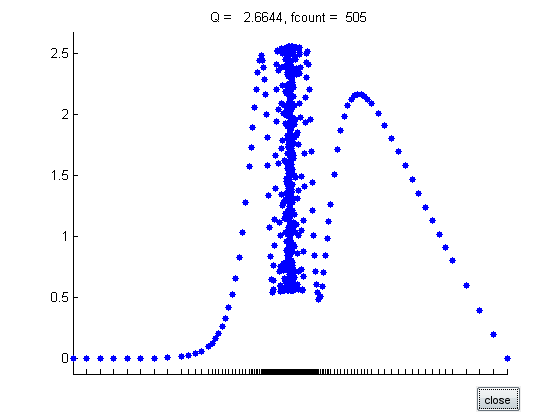QuadDemo.m
Contents
- Overview
- Inline functions are obsolete, so we no longer discuss their use.
- Integrand defined as anonymous function
- Integrand defined in external M-file besselintegrand.m
- Integrand defined as anonymous function with parameter
- Graphical illustration with quadgui
- An Experiment from NCM
- Other good examples for quadgui:
Overview
Illustrates the NCM routine quadtx (textbook version of quad) to perform numerical integration on the interval ![$[a, b]$](QuadDemo_eq40018.png) . Also illustrates different ways to define functions for use with function-functions.
. Also illustrates different ways to define functions for use with function-functions.
Inline functions are obsolete, so we no longer discuss their use.
Integrand defined as anonymous function
We evaluate

a = 0; b = 1; disp('Evaluate the complicated Bessel integral (f defined as anonymous function):') f = @(x) besselj(0,x).*x.*exp(x.^2); q = quadtx(f,a,b); disp(sprintf('Int(J0(x)*x*exp(x^2),x=%f..%f) = %15.12f.\n',a,b,q)) %pause
Evaluate the complicated Bessel integral (f defined as anonymous function): Int(J0(x)*x*exp(x^2),x=0.000000..1.000000) = 0.739631779804.
Integrand defined in external M-file besselintegrand.m
disp('Evaluate the complicated Bessel integral again (f defined in external M-file):') q = quadtx(@besselintegrand,a,b); disp(sprintf('Int(J0(x)*x*exp(x^2),x=%f..%f) = %15.12f.\n',a,b,q)) %pause
Evaluate the complicated Bessel integral again (f defined in external M-file): Int(J0(x)*x*exp(x^2),x=0.000000..1.000000) = 0.739631779804.
Integrand defined as anonymous function with parameter
We now evaluate

for values of 
disp('Evaluate even more complicated Bessel integrals:') f = @(x,n) besselj(n,x).*x.*exp(x.^2); for n=0:0.5:2 % The fourth argument for quadtx expects a tolerance for the adaptive % subdivision. Even if we don't want to change it, we still need to % reserve space for it. q = quadtx(f,a,b,[],n); disp(sprintf('Int(J_%2.1f(x)*x*exp(x^2),x=%f..%f) = %15.12f.\n',n,a,b,q)) end %pause
Evaluate even more complicated Bessel integrals: Int(J_0.0(x)*x*exp(x^2),x=0.000000..1.000000) = 0.739631779804. Int(J_0.5(x)*x*exp(x^2),x=0.000000..1.000000) = 0.518983492064. Int(J_1.0(x)*x*exp(x^2),x=0.000000..1.000000) = 0.288627069603. Int(J_1.5(x)*x*exp(x^2),x=0.000000..1.000000) = 0.137909969971. Int(J_2.0(x)*x*exp(x^2),x=0.000000..1.000000) = 0.058849406764.
Graphical illustration with quadgui
disp(sprintf('Now starting quadgui with Int(J_%2.1f(x)*x*exp(x^2),x=%f..%f)\n',n,a,b)) f = @(x) besselj(0,x).*x.*exp(x.^2); q = quadgui(f,a,b); %pause
Now starting quadgui with Int(J_2.0(x)*x*exp(x^2),x=0.000000..1.000000)
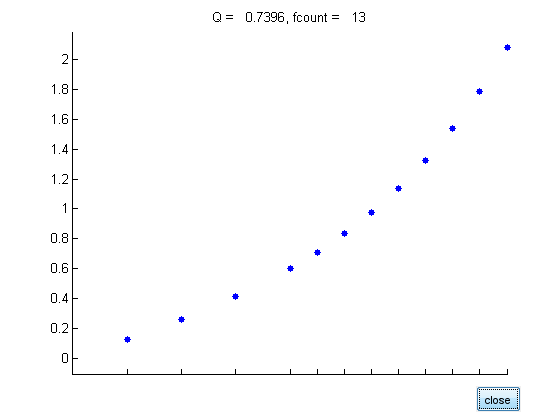
An Experiment from NCM
Modified to use the Bessel function integral
Qexact = 0.739631779338781; %Qexact = 29.85832539549867; disp('An experiment from NCM showing the effect of the tolerance') disp(' tol Q fcount err ratio') for k = 1:12 tol = 10^(-k); [Q,fcount] = quadtx(f,0,1,tol); % [Q,fcount] = quadtx(@humps,0,1,tol); err = Q - Qexact; ratio = err/tol; fprintf('%8.0e %21.14f %7d %13.3e %9.3f\n', ... tol,Q,fcount,err,ratio) end %pause
An experiment from NCM showing the effect of the tolerance
tol Q fcount err ratio
1e-001 0.73974118141456 5 1.094e-004 0.001
1e-002 0.73974118141456 5 1.094e-004 0.011
1e-003 0.73963369998902 9 1.921e-006 0.002
1e-004 0.73963212792942 13 3.486e-007 0.003
1e-005 0.73963178505244 25 5.714e-009 0.001
1e-006 0.73963177980438 33 4.656e-010 0.000
1e-007 0.73963177936419 57 2.541e-011 0.000
1e-008 0.73963177934112 89 2.339e-012 0.000
1e-009 0.73963177933896 121 1.821e-013 0.000
1e-010 0.73963177933879 221 7.550e-015 0.000
1e-011 0.73963177933878 349 7.772e-016 0.000
1e-012 0.73963177933878 485 2.220e-016 0.000
Other good examples for quadgui:
The humps function

disp('Starting quadgui again with more examples') disp('f(x) = humps(x) on [-1,2]') f = @(x) humps(x); a = -1; b = 2; q = quadgui(f,a,b); %pause
Starting quadgui again with more examples f(x) = humps(x) on [-1,2]
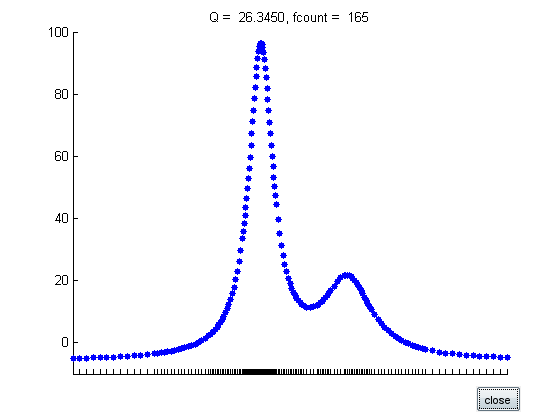

disp('f(x) = cos(x) on [0,9*pi/2]') f = @(x) cos(x); a = 0; b = 9*pi/2; tol = 1.e-6; q = quadgui(f,a,b,tol); %pause
f(x) = cos(x) on [0,9*pi/2]
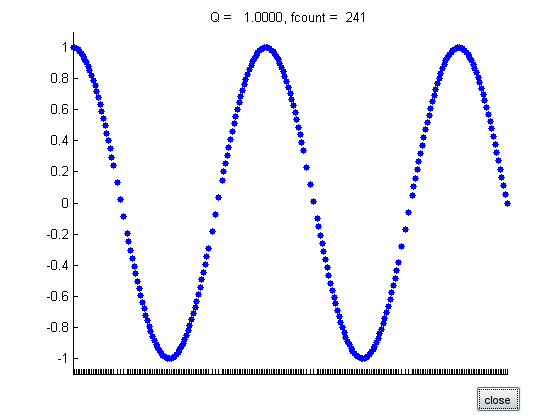

disp('f(x) = sqrt(x) on [0,1]') f = @(x) sqrt(x); a = 0; b = 1; tol = 1.e-8; q = quadgui(f,a,b,tol); %pause
f(x) = sqrt(x) on [0,1]
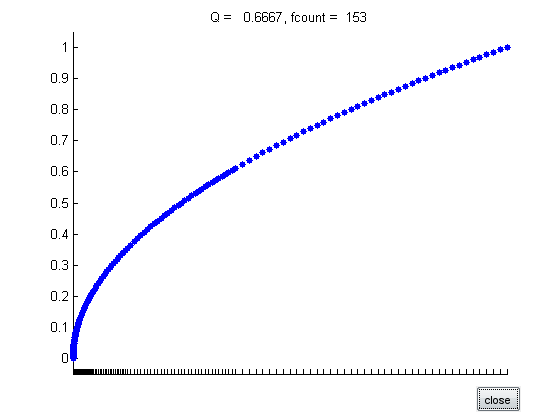

disp('f(x) = tan(sin(x))-sin(tan(x)) on [0,pi]')
f = @(x) tan(sin(x))-sin(tan(x));
a = 0; b = pi;
q = quadgui(f,a,b);
f(x) = tan(sin(x))-sin(tan(x)) on [0,pi]
